Force on a Current-carrying Conductor in a Magnetic Field
Force on a Current-carrying Conductor in a Magnetic Field: Overview
This topic covers concepts, such as, Force on a Current-Carrying Conductor in a Magnetic Field, Radius of the Circular Path of the Charge Particle in Magnetic Field,Motion of Charged Particle in Uniform Magnetic Field and Fleming's Left Hand Rule for the Direction of Magnetic Force etc.
Important Questions on Force on a Current-carrying Conductor in a Magnetic Field
A straight rod of mass m and length is suspended from the identical spring as shown in the figure. The spring stretched by a distance of due to the weight of the wire. The circuit has total resistance . When the magnetic field perpendicular to the plane of the paper is switched on, springs are observed to extend further by the same distance. The magnetic field strength is
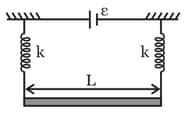
A block of mass and charge is released on a long smooth inclined plane. Magnetic field is constant, uniform and out of the plane of the paper as shown. Find the time from the start when block leaves contact with the surface.
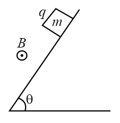
A particle with charge +Q and mass m enters a magnetic field of magnitude B, existing only to the right of the boundary YZ. The direction of the motion of the particle is perpendicular to the direction of B.
. The time spent by the particle in the field will be

Two particles of charges +Q and -Q are projected from the same point with a velocity v in a region of uniform magnetic field B such that the velocity vector makes an angle θ with the magnetic field. Their masses are M and 2M, respectively. Then, they will meet again for the first time at a point whose distance from the point of projection is
An electron moving with a velocity at a point in a magnetic field experiences a force . If the electron is moving with a velocity at the same point, it experiences a force . The force the electron would experience if it were moving with a velocity at the same point is
A particle of specific charge (charge/mass) α starts moving from the origin under the action of an electric field and magnetic field . Its velocity at is . The value of is :
A charged particle is released from rest in a region of uniform electric and magnetic fields, which are parallel to each other. The locus of the particle will be
A charged particle is released from rest in a region of uniform electric and magnetic fields, which are parallel to each other. The locus of the particle will be
is a current-carrying square loop. An electron is projected from the centre of the loop along with its diagonal as shown. The unit vector in the direction of initial acceleration is
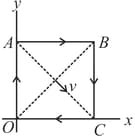
Electrons moving with different speeds enter a uniform magnetic field in a direction perpendicular to the field. They will move along circular paths,
An electron experiences no deflection, if subjected to an electric field of and a magnetic field of . Both the fields are normal to the path of an electron and to each other. If the electric field is removed, then the electron will revolve in an orbit of radius
An electron having kinetic energy T is moving in a circular orbit of radius R perpendicular to a uniform magnetic induction . If kinetic energy is doubled and magnetic induction tripled, the radius will become
A uniform magnetic field exists in a space. A particle of mass and charge q is projected towards negative x- axis with speed v from the a point (d, 0, 0). The maximum value v for which the particle does not hit y-z plane is
An electron is projected with velocity in a uniform electric field E perpendicular to the field. Again it is projected with velocity perpendicular to a uniform magnetic field B/If is initial radius of curvature just after entering in the electric field and is initial radius of curvature just after entering in magnetic field then the ratio is equal to
A particle of charge and mass starts moving from the origin under the action of an electric field with velocity The speed of the particle will become after a time
A long thin-walled pipe of radius carries a current along its length. The current density is uniform over the circumference of the pipe. The magnetic field at the centre of the pipe due to the quarter portion of the pipe shown, is
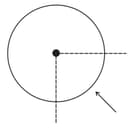

A charge particle of charge has velocity . When it passes through point and has velocity in the direction shown. The strength of magnetic field at point due to this moving charge is .
Two long parallel wires are at a distance 2d apart. They carry steady equal currents flowing out of the plane of the paper, as shown. The variation of the magnetic field B along the XX' is given by
An infinite wire placed along -axis, has current in positive -direction. A conducting rod placed in plane parallel to y-axis has current in positive y-direction. The ends of the rod subtend angles of and at the origin with positive -direction. The rod is at a distance from the origin. Find net force on the rod.
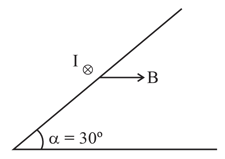
The figure shows a conductor of weight 1.0 N and length L = 0.5 m placed on a rough inclined plane making an angle with horizontal so that conductor is perpendicular to a uniform magnetic field of induction B = 0.1T. The coefficient of static friction between the conductor and the plane is 0.1, A current of I = 10A flows through the conductor inside the plane of this
paper as shown.
What is the force needed to be applied parallel to the inclined plane to sustain the conductor at rest.
